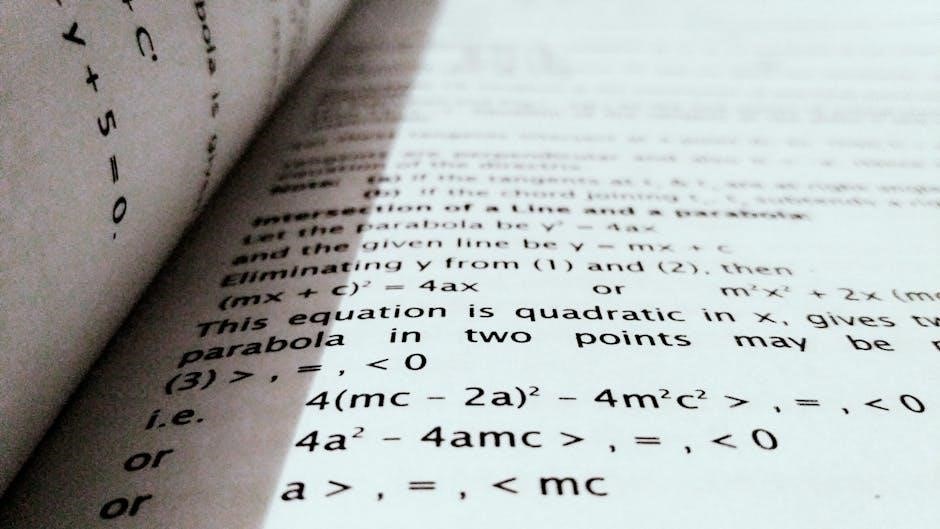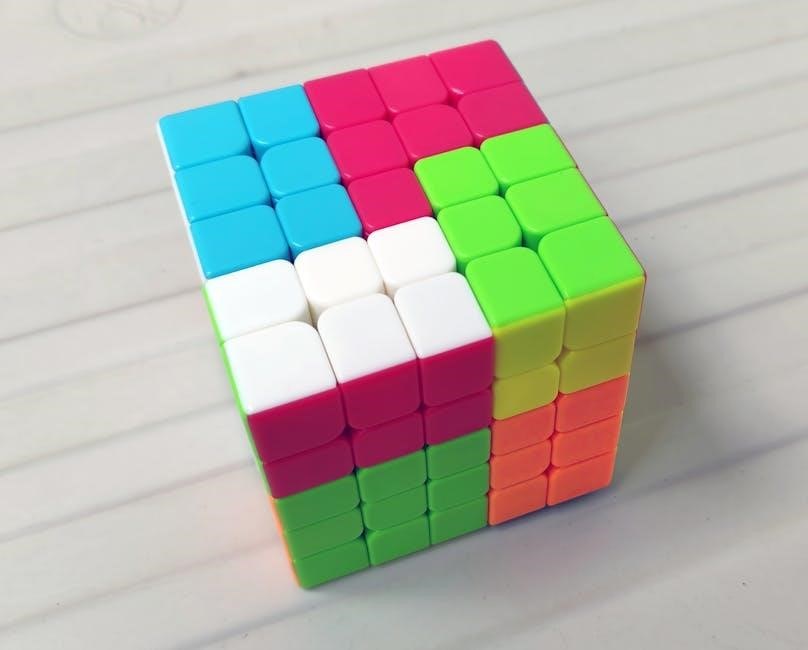Square root equations involve variables under radical signs, requiring algebraic techniques to isolate and solve for the variable. These equations are fundamental in algebra and often appear in real-world problems.
Mastering square root equations is essential for solving complex algebraic problems. They are widely used in geometry, physics, and engineering, making them a cornerstone of mathematical problem-solving skills.
Overview of Square Root Equations
Square root equations are algebraic equations where the variable is under a radical sign, such as √x = 5. These equations require specific techniques to isolate and solve for the variable. A common approach involves squaring both sides to eliminate the square root, but this must be done carefully to avoid extraneous solutions. Worksheets are an excellent resource for practicing these problems, offering a variety of exercises from simple to complex scenarios. They provide structured practice, helping to identify common mistakes and improve problem-solving skills. Mastering square root equations is crucial for solving real-world problems in fields like geometry and physics. Regular practice with worksheets helps build proficiency and confidence in handling such equations effectively.
Importance of Square Root Equations in Algebra
Square root equations are fundamental in algebra as they introduce students to radical expressions and inverse operations. These equations help develop critical problem-solving skills, essential for advanced mathematics. By solving square root equations, learners understand how to manipulate and simplify expressions, a skill vital for geometry, physics, and engineering. Worksheets dedicated to these equations provide structured practice, allowing students to grasp concepts like isolating radicals and squaring both sides. They also highlight the importance of checking solutions to avoid extraneous roots, ensuring accuracy. Mastering square root equations builds a strong algebraic foundation, enabling students to tackle more complex problems with confidence and precision.

Steps to Solve Square Root Equations
Solving square root equations involves isolating the radical, squaring both sides to eliminate the square root, simplifying the resulting equation, and checking for extraneous solutions to ensure accuracy.
Isolating the Square Root Term
Isolating the square root term is the first step in solving square root equations. This involves moving all other terms to the opposite side of the equation to ensure the radical is alone. For example, in the equation 2x + 3 = 5, subtract 3 from both sides to get 2x = 2, then divide by 2 to isolate x. Similarly, in equations with square roots, like √(x) + 4 = 10, subtract 4 from both sides to isolate the square root term, resulting in √(x) = 6. This step is crucial because it allows you to eliminate the radical by squaring both sides in the next step. Always remember to perform the same operation on both sides to maintain equality. Once the square root is isolated, the equation becomes simpler to solve, leading to accurate solutions. Proper isolation also helps in avoiding extraneous solutions that may arise during the process. By following this method, you can systematically approach and solve various types of square root equations efficiently.
Squaring Both Sides of the Equation
Squaring both sides of the equation is a critical step in solving square root equations. After isolating the square root term, squaring both sides eliminates the radical, simplifying the equation. For example, if the equation is √(x) = 4, squaring both sides yields x = 16. This method works because the square and square root are inverse operations. However, squaring both sides can introduce extraneous solutions, so it’s essential to check all solutions in the original equation. Always perform the squaring operation carefully to avoid errors. This step is fundamental in solving square root equations and ensures progress toward finding the correct solution. Proper execution of this step is vital for accuracy in the final answer.
Simplifying and Checking for Extraneous Solutions

After squaring both sides, simplify the equation by performing algebraic operations. This step may involve expanding terms, combining like terms, or isolating the variable further. Once simplified, solve for the variable to find potential solutions. However, squaring both sides can introduce extraneous solutions that do not satisfy the original equation. Always check each solution by substituting it back into the original equation. If a solution results in a negative value under the square root or does not balance the equation, it is extraneous and must be discarded. This verification step ensures the validity of the solutions. Proper simplification and careful checking are essential for accurate results when solving square root equations.

Types of Square Root Equations
Square root equations can be simple, involving isolated radicals, or complex, with multiple terms and variables. Each type requires specific strategies for effective solving.
Simple Square Root Equations
Simple square root equations involve a single radical term, such as x² = 25 or √x = 5. These equations are straightforward to solve by isolating the radical and squaring both sides. For example, in √x = 5, squaring both sides yields x = 25. Worksheets often include problems like 3√x = 12, where isolating the radical before squaring is essential. Resources like Kuta Software and Infinite Algebra provide extensive practice with these equations, ensuring mastery of basic techniques. Always check solutions in the original equation to confirm validity and avoid extraneous roots.
Complex Square Root Equations with Multiple Terms
Complex square root equations involve multiple terms and often require advanced techniques. For example, equations like 2(x + 3)² = 7 or √(2x + 5) = √(3x ౼ 1) demand careful manipulation. To solve these, isolate the radical, square both sides, and simplify. Worksheets from sources like Kuta Software provide extensive practice, including problems with variables on both sides and nested radicals. Always check solutions in the original equation to ensure they are valid. These equations prepare students for real-world applications in geometry and physics, where such problems frequently arise. Regular practice with these worksheets helps build proficiency in handling complex square root equations effectively.
Practical Applications of Square Root Equations
Square root equations are essential in geometry for calculating distances and areas, and in physics for solving motion problems. They are vital for real-world applications, enhancing problem-solving skills in various scientific fields.
Real-World Problems Involving Square Roots
Square root equations are commonly applied in real-world scenarios, such as calculating distances in geometry or solving physics problems involving motion. For example, an auditor might use square roots to determine the dimensions of a room with a known area, while a physicist could apply them to calculate the distance an object travels under constant acceleration. These equations also appear in engineering, architecture, and everyday problem-solving, making them indispensable tools for practical applications. By mastering square root equations, individuals can better understand and solve challenges in various scientific and professional fields. This skill is essential for accurately modeling and analyzing real-world phenomena, ensuring precise and effective solutions.
Using Square Root Equations in Geometry and Physics
Square root equations are integral to solving problems in geometry and physics. In geometry, they are used to calculate distances, areas, and volumes, such as finding the hypotenuse of a right triangle using the Pythagorean theorem. Physicists employ square roots to determine quantities like velocity, acceleration, and force. For instance, the equation for projectile motion involves square roots to calculate the maximum height or range of an object. These equations also appear in problems involving wave frequencies and light refraction. By applying square root equations, professionals can model real-world phenomena, ensuring accurate calculations and solutions. This mathematical tool is indispensable for analyzing and solving complex problems in both fields, bridging theory with practical applications.
Common Mistakes and Tips
Avoid common errors like forgetting to isolate the square root or squaring both sides incorrectly. Always check solutions by substituting them back into the original equation.
Identifying and Avoiding Common Errors
When solving square root equations, common errors often arise from improper isolation of the radical or incorrect squaring of both sides. For instance, failing to isolate the square root term can lead to unnecessary complexity and incorrect solutions.
- Always ensure the radical is isolated before squaring both sides of the equation.
- Be cautious of extraneous solutions that may appear after squaring both sides; verify all solutions in the original equation.
- Avoid forgetting to simplify fully after squaring, as this can result in quadratic equations that require further factoring or solving.
Practicing with worksheets and checking solutions step-by-step can help build proficiency and reduce errors over time.
Best Practices for Solving Square Root Equations
Following best practices ensures accuracy and efficiency when solving square root equations. Always isolate the square root term before squaring both sides to simplify the equation effectively.
- Isolate the radical: Ensure the square root term is alone on one side of the equation to avoid unnecessary complexity.
- Square both sides carefully: Apply the squaring operation to eliminate the square root, but remember this can introduce extraneous solutions.
- Simplify thoroughly: After squaring, simplify the resulting equation completely to avoid missing potential solutions.
- Check solutions: Verify all solutions in the original equation to eliminate extraneous results that may arise from squaring both sides.
- Practice consistently: Use worksheets to refine your skills and build confidence in solving square root equations.
By adhering to these practices, you can master square root equations and apply them effectively in various mathematical and real-world scenarios.

Worksheet Resources
Extensive collections of square root equation worksheets are available online, offering various difficulty levels and formats. Websites like Kuta Software provide customizable worksheets tailored to specific needs, ensuring targeted practice for different skill levels. Additionally, many educational platforms offer free downloadable PDFs that cater to both basic and advanced square root equation problems. These resources are invaluable for students seeking to master the concept through hands-on practice.
